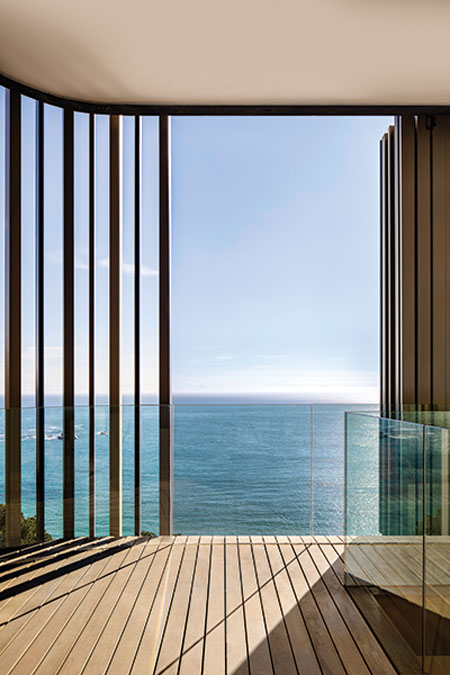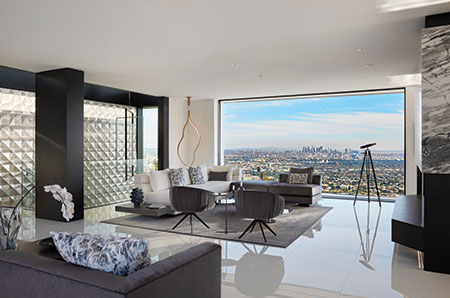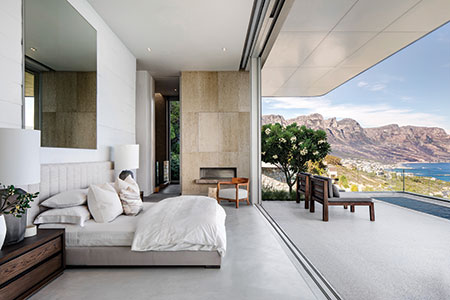Architectural Trends Are Heating Up Worldwide
by Natasha Wolff | October 17, 2019 12:30 pm
Traditional shingle-style houses, long pegged as the Hamptons look, are out. Forward-looking contemporaries, with broad stretches of retractable glass, high ceilings, and flat roofs outfitted as decks, have become the rage. In Miami[1], Los Angeles, and the Côte d’Azur, tile-roofed Mediterranean structures have similarly lost cachet to flat-topped contemporaries featuring stone walls and aluminum louvers with a wood look. The new, warmer aspect is now the style du jour in luxury enclaves and coastal communities worldwide.

Natural light filters into a modern home in Cape Town.
“Interest in modern or modernist architecture is more evident than ever, with more new homes being designed and built in this style in the Hamptons, across the country, and internationally,” says Nick Martin, a Hamptons-based architect who designs luxury estates and other high-end spaces in New York, the Caribbean, and Portugal.
Traditional styles of architecture “created homes that are inconsistent with the way people live today,” says Greg Truen, director at SAOTA, an award-winning architecture firm based in Cape Town, South Africa, that designs thoroughly modern houses across North America, Africa, Europe, Australia, New Zealand, and South Asia. “Contemporary architecture allows much more meaningful connections with views, external spaces, and gardens.”
In Bali, SAOTA—mindful of the tropical climate—created a resort-inspired split-level indoor-outdoor retreat with covered outdoor spaces, pavilions, and terraces. A stone plinth on a modern home built into a Cape Town mountainside is topped by a vertically slatted aluminum box with a bark-esque finish that lets natural light filter like a large shade tree over a mid-level terrace.
Though the first modernist villas emerged in 1930s Europe (followed quickly by others elsewhere), traditional designs still dominated. In the past decade, contemporary architecture came to the fore in places like California, South Florida, and South Africa, where indoor and outdoor living can be integrated more easily.

Inside a $28 million spec house in L.A.
In colder climates, particularly in Switzerland, modern designs took off when “technology allowed for open, interconnected spaces, surrounded by glass, to be heated efficiently,” Truen says.
In Cannes, France[2], contemporary homes in the hills make “the most of those sensational views over the azure water, with flowing accommodation and a beautiful infinity pool,” says Jack Harris, an associate with real estate consultancy Knight Frank. “They are a firm favorite with international buyers.”
Tropical modernism is all the rage in Miami, where architectural styles have evolved from the early-1900s Mediterranean Revival to Art Deco’s streamlined, rounded corners to 1950s Miami Modern, known as MiMo, followed by a Mediterranean resurgence. But now, “Mediterranean is virtually dead, and every buyer wants contemporary,” says Dina Goldentayer, a Florida-based agent at real estate powerhouse Douglas Elliman.
“At every price point for a waterfront home, the buyer prefers modern,” says Goldentayer, who specializes in Miami Beach’s ultra-luxury marketplace. “It’s been a good two years since I’ve shown a Mediterranean home.” Buyers prefer modern’s high ceilings and foldaway glass walls that facilitate “true indoor-outdoor living.”

A bedroom with a view in a mountainside Cape Town house.
Among her listings is an $18.5 million, 9,000-square-foot house designed by architect James Wall, with a sculptural facade, a pool off the second-floor master bedroom, and an 18-by-18-foot cantilevered glass box overlooking an aquatic atrium and Biscayne Bay.
“Today’s Miami Modern is the antithesis of the original movement,” Wall says. “We are moving away from the white box more. It’s becoming a warmer and warmer modernism.”
Miami’s tropical modern is influenced by Latin America and Mexico. Structural engineering and design also takes hurricanes and sea rise into account, Wall says.
In Los Angeles, a $28 million, 10,000-square-foot modern spec house by celebrity home developer Michael Mueller offers Hollywood Regency flair. The contemporary has a black stone and stainless steel facade with sword-shaped LED lights illuminating columns. Fluid living spaces open uninterrupted to outdoor lounges, a semicircular infinity pool, and panoramic views.
As Marc Noah of Sotheby’s International Realty, the property’s listing agent, says, what is desirable now are “homes that are contemporary, but not your standard cookie-cutter modern contemporary. It doesn’t have to be bigger or have more amenities; it has to have a unique and attractive look and design and feel.”
In other words, the rules of traditional architecture don’t apply.
- Miami: https://dujour.com/cities/miami-art-after-stonewall-lgbtq-exhibit-andy-warhol-jean-michel-basquiat/
- France: https://dujour.com/travel/french-chateau-luxury-hotels-resorts-destinations/
Source URL: https://dujour.com/design/modern-architecture-trends-hamptons-miami-portugal/